Degenerative myelopathy is a progressive condition that affects the spinal cord of older dogs. If your dog has recently been diagnosed, you don’t have to face the journey alone. Today, Dr. Susan Davis, internationally recognized physical therapist for animals—and friend of Dr. Julie Buzby—shares hope-filled guidance so you can care for your beloved dog with compassion and confidence.

You know something is wrong. You see your dog struggle to stand up, and when he finally does, he strains to move, dragging his hind legs behind. If your dog is a breed genetically linked to developing degenerative myelopathy, you may have heard the name before and find yourself filled with a sense of dread.
- Caring for your dog with degenerative myelopathy
- What is degenerative myelopathy?
- Which breeds are at risk of degenerative myelopathy?
- What are the symptoms of degenerative myelopathy?
- How is degenerative myelopathy in dogs diagnosed?
- How can I help my dog who has just been diagnosed with degenerative myelopathy?
- When it's time to say goodbye
- Have you walked through degenerative myelopathy with your dog?
Caring for your dog with degenerative myelopathy
Or maybe the condition is completely unfamiliar to you, and you find yourself sitting in an exam room, suddenly thrust into unknown territory. Your veterinarian has just suggested the possibility of this diagnosis, and you are wondering what that means for your beloved senior dog.
No matter which of these scenarios describes you, I am here to help.
As a physical therapist in the veterinary field, I’m very familiar with dogs who have degenerative myelopathy since treatment often includes techniques that fall squarely into my area of expertise.
When Dr. Buzby asked me to offer advice and encouragement to pet parents facing degenerative myelopathy, I knew she would want me to leave you better informed and better equipped to handle the situation you’re facing.
My hope is to do just that.
So let’s look at degenerative myelopathy. First, what it is, which breeds it affects, the most common symptoms, and how it’s diagnosed. Then, I’ll share 5 bits of advice that will help you put together a treatment plan you can easily begin to implement today.
But first, the good news
Before moving on, I’m compelled right off the bat to share the good news about having a senior dog with degenerative myelopathy. I’m guessing it’ll instantly lift your spirits and soothe your worries.
Degenerative myelopathy is considered painless, and while its symptoms are progressive, visible, and sometimes hard to watch, your dog isn’t in pain. He’s happy to be by your side eating up every snuggle, sweet word, and special treat. If you provide for your dog’s daily needs, as you have been doing for years, he will remain happy and content!
Now, with that good news in mind, let’s learn a little about degenerative myelopathy.
What is degenerative myelopathy?
Degenerative myelopathy, also known as DM, is a chronic, slow-developing neurological disease similar to Amyotrophic Lateral Sclerosis (ALS or Lou Gehrig’s disease) in human beings.
DM causes degeneration of the axons (i.e. long “arms” of nerve cells) that send signals within the spinal cord. Initially it affects the ability of nerve signals to get to the hind limbs, but eventually the whole spinal cord is affected. Therefore, the dog will have hind limb weakness and then paralysis early on in the disease. But in the final stages of DM, the dog also experiences front leg weakness than paralysis, and difficulty swallowing or breathing.
Which breeds are at risk of degenerative myelopathy?
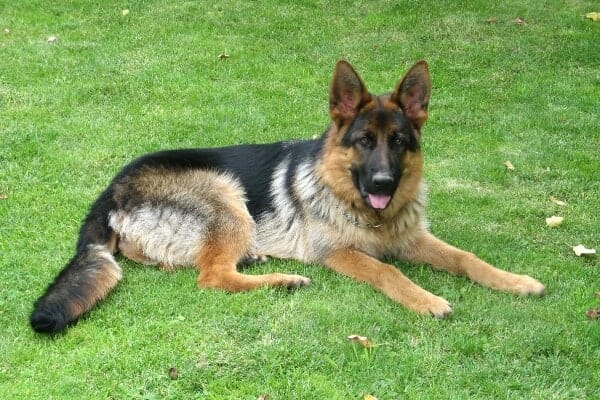
Breeds genetically predisposed to DM include:
- Boxers
- Chesapeake Bay Retrievers
- Collies
- German Shepherds
- Pembroke Welsh Corgis
- Rhodesian Ridgebacks
What are the symptoms of degenerative myelopathy?
DM typically occurs in middle-aged to older dogs between seven and fourteen years of age. Generally, the condition progresses over several months to a year, and sadly, is fatal. Dr. Buzby and I have both had patients outlive a year, so that timeline is certainly not fixed.
As the disease progresses, you may observe:
- Weakening in your dog’s hind limbs and lower back
- Wasting away of muscle mass
- Paralysis
- Knuckling of the paws
- Loss of coordination
- Difficulty walking
How is degenerative myelopathy in dogs diagnosed?
Your veterinarian will diagnose DM by identifying its clinical signs, and by ruling out other causes of neurological disease. A radiograph will help determine if hip dysplasia, spinal disc herniation, or a tumor is the cause of the symptoms instead.
After ruling out other causes, your vet may also run a DNA test for potential blood markers through the Orthopedic Foundation for Animals. This is the most definitive diagnostic test for DM, yet it still doesn’t guarantee that your dog has or will have the condition, only that he inherited the genes to develop the condition.
The OFA classifies dogs as Normal, Carrier, or At-Risk. Normal dogs have no genetic mutations for DM and are highly unlikely to get this condition.
Carrier versus at-risk
A dog who is a “carrier” has one normal gene and one mutated copy of the gene for DM. Dogs are called carriers because one out of two of the genes is abnormal while the other is normal. Carriers are much less likely to develop DM than dogs who have 100% mutation (both genes are affected). These dogs are classified as “at-risk” because they possess two mutated copies of the gene.
The OFA website explains it best, “At this point, the mutation can only be interpreted as being at risk of developing DM within the animal’s life. For dogs showing clinical signs with a presumptive diagnosis of DM, affected “at-risk” test results can be used as an additional tool to aid in the diagnosis of DM.”
As practitioners, when we pair clinical symptoms in an older dog with “at-risk” genetics, we make a presumptive diagnosis of degenerative myelopathy.
How can I help my dog who has just been diagnosed with degenerative myelopathy?
Caring for a dog with degenerative myelopathy is a team effort, but a job that’s totally manageable once you have a plan in place. Here are five ways you can pull together a solid treatment plan and provide a high level of care for your dog.
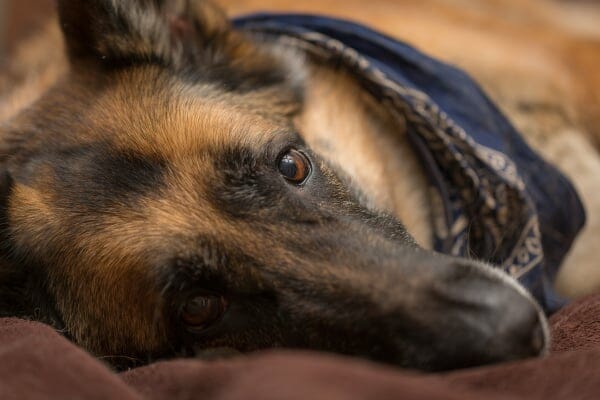
1. Engage your family.
Gather the family together and have an honest discussion involving the current and future needs of your precious dog. Each family member must be prepared to face the gradual decline of your dog’s health. Round-the-clock care may eventually become the new reality.
Nevertheless, as soon as a daily routine is set where everyone is involved and committed to the same goals, the workload is manageable—best of all, your dog will love all the attention!
2. Learn best practices from your veterinarian.
Your veterinarian and staff will advise you regarding medications, supplements, and dietary needs. They are also the best qualified to teach you how to assist your senior dog with bowel and bladder care.
Bowel care
As DM progresses, your dog may become incontinent, losing control of his bowels. Frequent trips outdoors to do “business” will help avoid accidents in the house. Special padding and diapering can also help manage this issue. Taking one last potty break right before bed will be invaluable in helping to keep your dog comfortable, clean, and dry overnight.
Bladder care
Your dog’s bladder, on the other hand, may lose the ability to void urine, causing it to accumulate and stretch the bladder. You will need to encourage regular emptying to promote bladder health and avoid urinary tract infections.
Your veterinary team will teach you how to express the bladder manually using gentle hand pressure over the lower abdomen. Urine scalding in dogs, similar to a burn, may occur on the delicate areas of the groin and under the tail if the urine soaks into your dog’s coat.
As a part of bowel and bladder care, remember to check the skin and fur for soiling and keep the areas clean and dry.
3. Consult a veterinary physical therapist.
Your veterinarian may refer you to a veterinary physical therapist trained in rehabilitative techniques. I strongly recommend adding a physical therapist to your dog’s healthcare team.
A veterinary physical therapist can provide your dog with treatment methods largely unavailable in a traditional vet clinic—such as strategic exercises, massage, electrical stimulation, and cold laser.
Strategic exercises
Though the disease is incurable, strategic exercises will help your dog stay active, strong, and feeling comfortable.
Here is a sampling of exercises to treat dogs with degenerative myelopathy:
- Range of motion movements with stretching of tight muscles
- Placing the dog over a physio ball to take the pressure off weight-bearing joints
- Massages and light exercise to preserve mobility
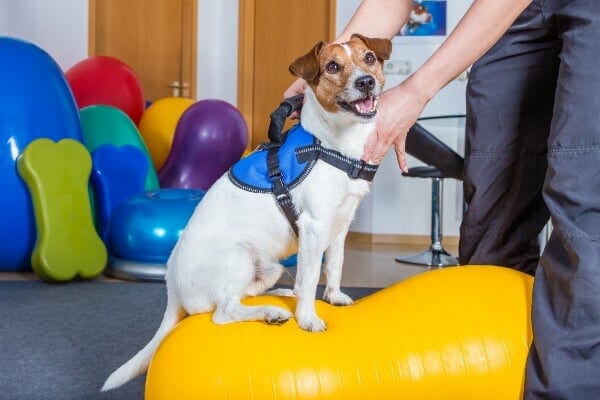
Some of these are performed daily, and others just two or three times per week. A physical therapist can develop a custom rehab schedule tailored to your dog’s needs.
Electrical stimulation and cold laser
In my practice, I have also had success adding electrical stimulation and cold laser to my DM exercise programs. What’s even more exciting is the recent scientific studies that support such methods.
One study was conducted by Dr. Debbie Torraca, a world-renowned physical therapist and owner of Wizard of Paws in East Haddam, Connecticut. She and her research partners found evidence that adding cold laser to a dog’s physical therapy program added more time to the dog’s lifespan and slowed the disease progression.
Their study collected and tested data compiled over eight years, comparing 20 DM dogs who received varying dosages and wavelengths of cold laser to the spine—in addition to rehabilitative exercises. The statistical results showed a slower decline in the disease progression and an extension in the time from onset to euthanasia by 11 to 12 months!
DM study results explained
The study hypothesized those wonderful joules of light coming from a cold laser unit, emitting wavelengths of 980 or more nanometers, helped suppress the cells attacking the nerve covering. This is really exciting for senior dogs facing a degenerative myelopathy diagnosis.
Please be aware that you will not find at-home lasers that meet these specifications sold to the public. You will need a veterinary PT professional to administer this type of laser therapy.
4. Research supportive aids for your dog.
In addition to exercise, electrical stimulation, and cold laser, there are wonderful products and resources out there to help you care for your dog.
Here are a few of my favorites:
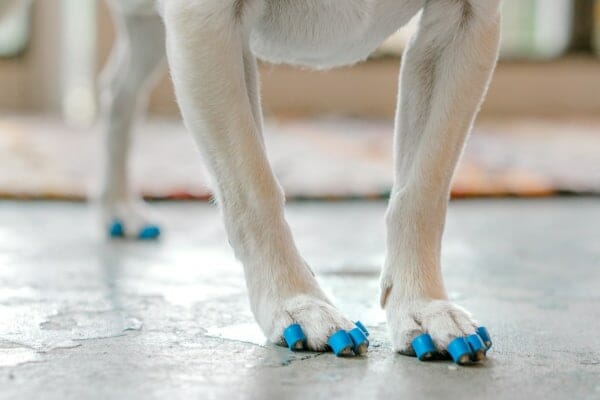
- ToeGrips® dog nail grips: If you see your dog slipping on tile or hardwood floors, dog nail grips provide a wonderful solution for traction and stability. Because DM dogs “scuff” their paws, I recommend affixing the ToeGrips to the nails with super glue. ToeGrips have the added benefit of providing “proprioceptive stimulus”—meaning they help draw the brain’s attention to the paws and improve the dog’s gait.
- Dogs unable to control the “knuckling under” of their toes need extra assistance for raising the paw and placing it properly on the floor. Try Dorsi-flexion assist supports with ankle cuffs and straps from Thera-paw or Handicapped Pets.
- In the most severe cases where walking is too difficult, a wheeled cart provides a handy mobility solution that your dog will enjoy.
- For shorter, quick trips outdoors, use a belly sling or body harness to assist with the task of walking, such as the GingerLead® rear support harness or the Help ‘Em Up™ Harness 2-handled harness.
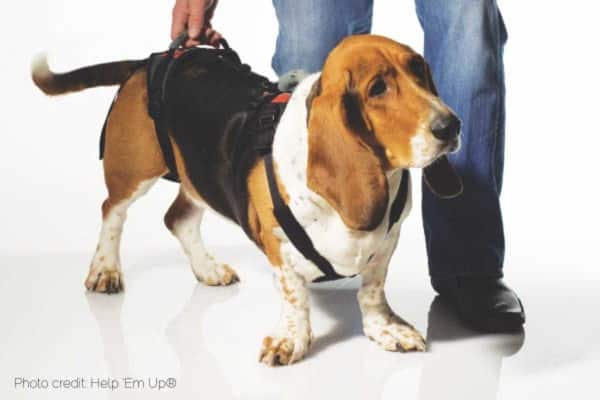
5. Put your blinders on.
Now that you have the plan to care for your dog, a healthcare team in place, and several convenient supportive aids to make life easier for your dog, the final thing you need to do is to put your blinders on.
Wait, hold on there…what?
Well, this may be easier to explain if I simply share a story that encompasses a multitude of experiences told to me by many DM dog owners over the years. It usually sounds something like this:
“Dr. Davis, you won’t believe what happened to me in the parking lot at the vet’s office last week! I was helping Jessie back to the car with a belly sling and a woman asked, “Oh, what’s wrong with your dog? Why can’t he walk?”
I answered, “He has a neurological disease called degenerative myelopathy. Don’t worry, he’s fine.”
She replied, “Well, he doesn’t look fine; he looks like he’s in pain and is suffering! What a poor thing! How can you let him live like this? Doesn’t the vet tell you to put him down?”
Ugh! How my heart aches for my clients who’ve been on the receiving end of such harsh comments from strangers, neighbors, or even friends and family.
Here’s when you need to put your blinders on, stick to your thoughtful plan of care, and not allow unsolicited opinions to derail what you know is best for your dog. The truth is, the average person doesn’t know enough about DM to even have such an opinion.
It may also be helpful to have a response ready when such comments come your way. Something like, “Thank you for your concern. Have a good day.” should suffice. Wink.
When it’s time to say goodbye
Degenerative myelopathy is a diagnosis no dog owner wants to hear, but you and your dog can still enjoy many months, or even years, on the back side of a diagnosis.
And when it is finally time to say goodbye to your dog, trust your faithful companion and your veterinary team to let you know. Until then, be confident as you courageously face degenerative myelopathy side by side with your beloved friend.
Have you walked through degenerative myelopathy with your dog?
Share your story in the comments below. We’d love to learn from your firsthand experience.


Our German shepherd Ike is 6 years old and at first was misdiagnosed with hip dysplasia. Unfortunately we got the dna test result 2 weeks ago. and both recessive traits for DM. We are going to the neurologist in a couple of weeks. He is getting water treadmill and laser. What do you think of stem cell for DM?
Thanks for the article. How can we put the nail grip on when his back legs the middle nails have worn down
. He does have knuckling… should we use the boots instead?
Hi Renee,
I am sorry Ike is facing this devastating diagnosis but glad to hear you have an appointment scheduled with the neurologist. I am not sure if stem cell therapy is effective for this condition, but it would be worth discussing with the specialist. If the middle two toenails are too worn down for ToeGrips, they can still be applied to the two outer toes on each rear foot. They would need to be applied with a tiny bit of super glue gel to prevent them from getting rolled downward when your boy drags his feet. Here is a link to our video on how to apply with glue: https://youtu.be/E8Du8O48L3I?si=WDGeNGPObTXZduqD
Hopefully, if he can get more traction, with time the middle nails may be able to grow out a bit and then ToeGrips could be applied to all 4 nails on each rear foot. Boots definitely have their place and can help once Ike reaches the point of dragging his feet, but generally I don’t like them for the early stages of DM as they take away all of the dog’s proprioception (feeling where your feet are in your environment), and they cannot engage their nails like cleats to grip the ground as is natural for their species. If you have any other questions about ToeGrips or need help with sizing and application, don’t hesitate to reach out to our expert customer care team at: [email protected]
They are also great at helping troubleshoot should any problems arise. Hoping Ike can maintain his quality of life for as long as possible. Wishing you continued success and many happy days ahead. Bless you and your sweet boy. ♥
Also, here is a link to another article about DM. It may have additional information that could be helpful: Degenerative Myelopathy in Dogs: Stages, Symptoms, Care
Thank you for all the good information! My dog is 8 years old and has DM . It is so hard to see him deteriorating! At the moment he is taking lion mane. Rose hip, fish oil, green lipped mussel and virimine B complex but nothing seem to help his back leg that don’t work anymore . He is still pee and poo by himself but he is struggling. I hope they will find a cure soon for this horrible il ess .
Dear Ludo,
My heart aches for you as you face the progression of this terrible disease in your pup. I agree, the day when we finally find a cure for DM cannot come soon enough. Make the most of the time you are gifted and lavish your sweet boy with love and affection. Wishing you both all the best and give your boy a hug for me. ♥
Our 12 year old male GSD was just diagnosed with DM. We knew there was something wrong for several months. Initially, the vet said it was not DM and just arthritis. He has been on pain meds for a while now and just never got any better and over the last couple weeks, he has gotten much worse. His mind is still sharp and he still wants to play frisbee but he just can’t. It is getting hard for him to walk. He is a big GSD, (thin 90 lbs) he was as much as 110 lbs. It is going to be hard to carry him around when he gets to where he can’t walk anymore. Does anyone else have a large GSD? How did you get him around? Do they make wheels big enough and how do they work? Thank you.
Dear Otis,
I am so sorry your senior Shepherd has received this devastating diagnosis. There are a few companies that make wheels for larger dogs. With that being said, if your boy is already losing mobility, you may not have enough time to get him measured and order the wheels before his quality of life has declined to where the wheels are not as helpful as we would want. Unfortunately, with this disease, the loss of mobility usually leads to making some tough decisions. I have had a few clients that used a small wagon to take larger dogs for “walks” so they can still enjoy getting outside and smell/sniff around. Here is a link to a website for disabled dog equipment with which I have had many good experiences: https://www.walkinpets.com/
Hoping you can find what works best for you and your sweet boy. Praying for strength as you navigate this difficult path and wishing you both comfort and peace.
My sweet Virginia, has been diagnosed with spinal deterioration; she has difficulty going up stairs, and I have seen some of the knuckling. I just ordered the toe togs for her. I hope they help ! We used to go for 2 mile walks- now we are down to a half mile.. one-off the pet stores has an underwater treadmill- do you think this would be helpful?
Is it suggested to superglue the toe togs on? Yikes! How would you ever get them off ? What about mail growth?
Hi Rita,
I am sorry Virginia has received such a difficult diagnosis. I love underwater treadmill and it is very likely this could be a valuable part of your dog’s treatment plan. I would discuss this possibility with your vet or a veterinary rehabilitation professional. Thank you for giving ToeGrips a try! I am hopeful they will give your sweet girl the traction she needs to continue to be mobile. The use of super glue is to ensure the ToeGrips stay in place when dogs have neurological deficits and knuckling is present. I encourage you to reach out to our customer care team with your questions and concerns about gluing the ToeGrips and nail maintenance. You can reach out by email at [email protected] or via text at (843)781-7430. This way we can ensure you receive personal individualized attention. Best wishes!
There is a significant difference between Degenerative myelopathy and Pug myelopathy. In Pugs the disease rarely progresses past the rear hind quarters and usually involves the bladder and bowel, but not always.
We found out about Pug myelopathy after our 10 year old Pug Maxster was diagnosed by our Vet with Degenerative myelopathy. My Wife spent many hours researching and found that Pugs get a different type which allows the Pet to live a fairly normal life span. We were stunned as was our Vet who contacted the University On Minnesota where the research was being performed.
Needless to say it was a great relief to know Maxster would be with us longer. We did have to express his bladder, but his bowels moved normally.
Maxster lived to 15 years old.
Hi Brian,
What a blessing your sweet boy was able to enjoy 15 years of life! Thank you for sharing your experience and giving hope to other readers. May Maxter’s memory never be forgotten.
My 12 year old girl German Shepherd just got diagnosed on monday. I knew for few weeks something was wrong. She started being weak in her hind legs.
She is already on Chaga, Astaxantin and CBD oil and I just added B1 and learned about NAC and curcumin.
She never went in the pool, didn’t like it so water therapy is out. Acupuncture, the stress of going places, possible anesthesia is out.
This leaves me with red light therapy-not sure if it will do anything, walking and massages.
Her tail is almost not moving. Missing her tail making circles!
As long as she eats and can get up and looks happy! When any of it changes, I will let her go with dignity.
She is a rescue who was abused to the point of starving and very ill.
I will let her go while she is happy free spirit nor stressed out, not understanding why she she ended up not being able to move.
It will be hard time to let go but it is not the first time or last time. With every loss, piece of my heart goes with them.
I feel for all that experienced the loss of bellowed pet.
Dear Hel,
I am sorry your senior girl has such a sad prognosis but am glad you have some answers and know what to expect. Allowing her to find rest while she is still happy and has some dignity sounds like such a loving choice. I hope you can make the most of the time you have left together. Wishing you comfort and peace.
My senior German Shepherd had DM. He was about 12.5 at the time of diagnosis. This is a fantastic article! We managed excellent care of him, during this time, with Tog Grips, Laser Light Therapy, and Acupuncture. It is amazing what a difference these combined treatments did for him. Unfortunately, we had the difficult decision to help him crossover to Rainbow Ridge at 13.5 yrs old, but the extra year spent with him was healthy for both of us. Without the palliative care, we might not have had that extra time. So grateful. This article is definitely an example of my own experience. Thank you for sharing tips like these.
Joann, I’m so sorry to read of your loss of your beloved German Shepherd. Your depth of care, love, and compassion for your dog are so obvious in your words. I’m sure it was a very difficult decision and my heart goes out to you. However, I’m greatly encouraged by your kind words about our article. We strive to provide high quality, “vetted” information in our weekly blog about older dog health and wellness. Thanks for being a Buzby Bark reader. ♥️